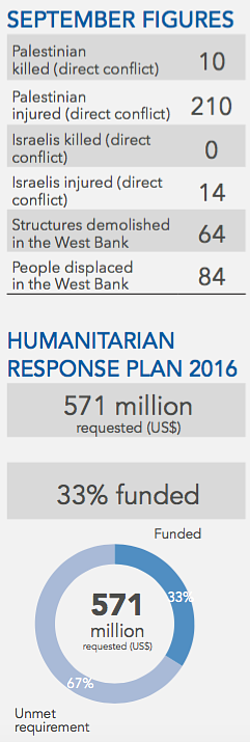Monthly Overview: September 2016
During the third week of September, the number of Palestinian attacks and alleged attacks against Israelis was the highest recorded since the escalation in the last quarter of 2015. In all, seven suspected Palestinian perpetrators were killed on the spot, including two children, and eight Israelis were injured. The number of live ammunition injuries among West Bank Palestinians rose during July and August; two-thirds of these injuries occurred in refugee camps, mainly in clashes during search and arrest operations. More than 300 Palestinians have been shot and injured with live ammunition since the beginning of the year (up to the end of August), including cases involving life-term disability. The use of firearms in densely-populated areas, resulting in deaths and serious injuries, raises concerns about the possible use of excessive force that may have led to unlawful killings. 
In August, the Gaza Strip witnessed the most intensive series of airstrikes and tank shelling attacks since the 26 August 2014 ceasefire that ended 51 days of hostilities. The recent incidents, which resulted in no fatalities, reportedly occurred in response to the shooting of one projectile into an Israeli city. Two years after the 2014 hostilities, which resulted in the death of 1,460 Palestinian and five Israeli civilians, serious concerns persist about the lack of accountability for alleged violations of international law, and the lack of civil remedies and compensation to victims. The Israeli Military Advocate General has received complaints relating to approximately 360 incidents, but only one case of looting has led to an indictment so far. No meaningful investigation into alleged violations has been announced by the Palestinian authorities so far. The failure to ensure accountability leaves victims and families without redress and creates an environment in which perpetrators on all sides are able to act with impunity, encouraging further abuses.
This month’s Humanitarian Bulletin examines the challenges facing pupils in Gaza as the new school year begins. Although most of the infrastructure damaged during the 2014 hostilities has been repaired, the educational system faces chronic challenges, in particular overcrowded schools resulting in widespread double shifts. The performance of students is also undermined by recurrent power outages and electricity rationing, poor shelter and living conditions, and economic deprivation. Over 6,000 teachers have not received regular monthly salaries since April 2014. Schools in Gaza have not received an operating budget from Ramallah for the third consecutive year and are, once again, forced to rely on revenues from school canteens to cover their operating costs.
Another chronic problem affecting Gaza, also addressed in this Bulletin is the longstanding electricity deficit which continues to undermine the delivery of basic services, in particular health, water and wastewater, and refuse collection. According to a recent report on the performance of the private sector in the Middle East and North Africa region, losses due to power outages in Gaza are the highest among the eight economies surveyed and constitute 22 per cent of annual sales.[1]
To ensure a minimum functionality of key service providers, humanitarian partners have been delivering emergency fuel supplies to health facilities, water and wastewater installations, and solid waste management facilities.
Addressing the UN Security Council on 15 September, the Secretary-General referred to the Gaza Strip as “a ticking time bomb” where “instability and the risk of violent escalation are ever-present.” He warned that “the continued humanitarian deprivations of Gaza’s nearly two million residents smother dreams and ambitions, and feed instability and extremism. Lasting progress in Gaza can only be realized on the basis of Palestinian unity, an end to the illicit arms build-up and militant activities, and a full lifting of movement and access restrictions in line with Security Council Resolution 1860.”
[1] European Bank for Reconstruction and Development, European Investment Bank, World Bank Group: What’s holding back the private sector in MENA? Lessons from the Enterprise Survey, p. 128.










